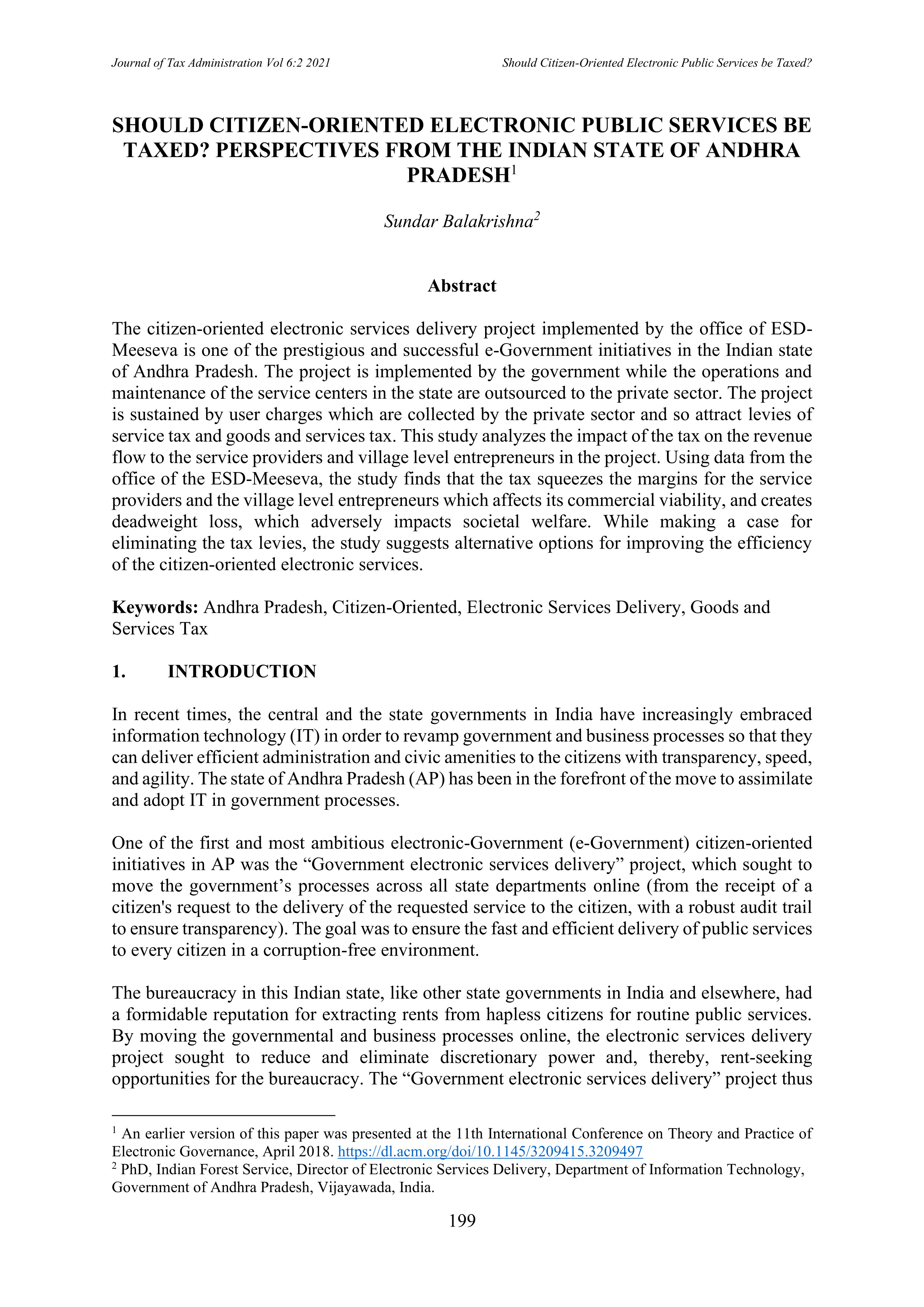Should Citizen-Oriented Electronic Public Services be Taxed? Perspectives from the Indian State of Andhra Pradesh
Keywords:
Andhra Pradesh, Citizen-Oriented, Electronic Services Delivery, Goods and Services TaxAbstract
The citizen-oriented electronic services delivery project implemented by the office of ESD- Meeseva is one of the prestigious and successful e-Government initiatives in the Indian state of Andhra Pradesh. The project is implemented by the government while the operations and maintenance of the service centers in the state are outsourced to the private sector. The project is sustained by user charges which are collected by the private sector and so attract levies of service tax and goods and services tax. This study analyzes the impact of the tax on the revenue flow to the service providers and village level entrepreneurs in the project. Using data from the office of the ESD-Meeseva, the study finds that the tax squeezes the margins for the service providers and the village level entrepreneurs which affects its commercial viability, and creates deadweight loss, which adversely impacts societal welfare. While making a case for eliminating the tax levies, the study suggests alternative options for improving the efficiency of the citizen-oriented electronic services.
References
Asogwa, B. E. (2013). Electronic government as a paradigm shift for efficient public services: Opportunities and challenges for Nigerian government, Library Hi Tech, 31(1), 141-159. https://doi.org/10.1108/07378831311303985
Balakrishna, S. (2018, November). Government electronic services delivery and the digital divide: The case of Andhra Paresh, India (ADPI Working Paper Series No. 890). https://www.adb.org/sites/default/files/publication/467826/adbi-wp890.pdf
Balakrishna, S., & Venkataramanaiah, S. (2016). Impact of information technology-enabled services on the state GDP: A case of Andhra Pradesh - India. Paper presented at the 27th Annual Conference of the Production and Operations Management Society, Orlando, Florida. https://www.pomsmeetings.org/ConfProceedings/065/Full%20Papers/Final%20Full%20Papers/065-0687.pdf
Burgess, R., & Stern, N. (1993). Taxation and development. Journal of Economic Literature, 31(2), 762-830.
Dunleavy, P., & Margetts, H. Z. (2010, September). The second wave of digital era governance. Paper presented at the 2010 Annual Meeting of the American Political Science Association. http://eprints.lse.ac.uk/27684/
Mittal, M. (2017, 29 June) GST’s red carpet entry: Impact on consumers, traders, government. India Today. https://www.indiatoday.in/india/story/gst-launch-gst-impact-on-consumers-goods-and-the-services-tax-nda-government-1021680-2017-06-30
Parkin, M. (2011). Microeconomics (10th edition). Boston, MA: Addison Wesley.
Reddick, C. G., & Turner, M. (2012). Channel choice and public service delivery in Canada: Comparing e-government to traditional service delivery. Government Information Quarterly, 29(1), 1-11. https://doi.org/10.1016/j.giq.2011.03.005
Saha, P., Nath, A., & Salehi-Sangari, E. (2010). Success of government e-service delivery: Does satisfaction matter? In M. A. Wimmer, J. L. Chappelet, M, Janssen, & H. J. Scholl (Eds.), Electronic government: 9th International Conference, EGOV 2010, Lecture notes in computer science, vol 6228. Berlin, Germany: Springer.
Stiglitz, J. E., & Rosengard, J. K. (2015). Economics of the public sector (4th edition). New York, NY: W. W. Norton & Company, Inc.
Tan, C.-W., Benbasat, I., & Cenfetelli, R. T. (2013). IT-mediated customer service content and delivery in electronic governments: An empirical investigation of the antecedents of service quality. MIS Quarterly, 37(1), 77-109.

Downloads
Published
How to Cite
Issue
Section
License
Copyright (c) 2021 Sundar Balakrishna

This work is licensed under a Creative Commons Attribution 4.0 International License.
Our open access status means that authors retain the copyright of their work. However, all papers published in JOTA are done so under a Creative Commons Attribution 4.0 International license (CC BY). This means that others can share and/or adapt your work without your permission as long as they follow certain rules, including attributing your work correctly.
You can learn more about this on our Open Access, Licensing, and Copyright Policies page.



